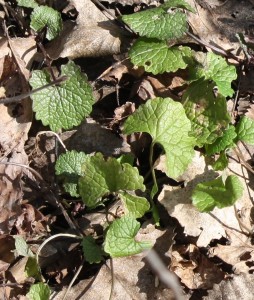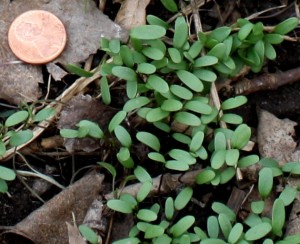My dreams nightmares are filled with garlic mustard rosettes popping up here, there and everywhere. I frantically try to control the spreading garlic mustard deciding which plants to pull and which to spray with a low concentration of glyphosate (2-3%). The battle is exhausting . . . and then I awake, at 3:00 AM, to the realization that my garlic mustard nightmare is reality.
Garlic mustard is to our woodlands and natural terrestrial areas what zebra mussels, Asian carp, etc., etc., are to aquatic resources. The National Park Service says “garlic mustard is poised to dominate the plant life of the United States”. Hmmm – the National Park Service seems like a credible group, not prone to exaggeration. Just to be sure we understand that garlic mustard is a serious threat to our natural environment, check out this quote from CABI, “Garlic mustard is considered one of the most serious invaders in the northeastern and Midwestern USA and southeastern Canada”.
CABI is an international, not-for-profit, science-based development and information organization. CABI is working in partnership with the University of MN and others to research biological control options for invasive plants, including garlic mustard. Biological control options exist but need further testing to rule out a hazard to native species that could be attacked along with garlic mustard.
In spite of the lack of publicity, it’s obvious that garlic mustard is a very real and significant threat. How can we control the spread of garlic mustard? In early spring, typically March, seeds that were previously dispersed germinate. Throughout the remainder of year one, these seedlings develop into small rosettes. Two control options exist at this stage of growth and development:
- Garlic mustard at this stage of growth may be sprayed with a low concentration of glyphosate (2-3% active ingredient strength). Spraying should be completed by a trained individual or licensed applicator in early spring or late fall when risk of damage to native plants is minimal. ALWAYS follow the label instructions provided by the herbicide manufacturer.
- Do nothing at this stage. Fifty percent or more of the seedlings will out-compete each other. If you are battling a large infestation of garlic mustard, your priority is to focus on removing the second year, seed-producing garlic mustard plants.
In my next blog segment, the main focus of control will be to stop seed production from occurring when second year garlic mustard plants prepare to blossom. Your assignment today and forever more, is to spread the word (not garlic mustard) to others about the importance of garlic mustard control.




